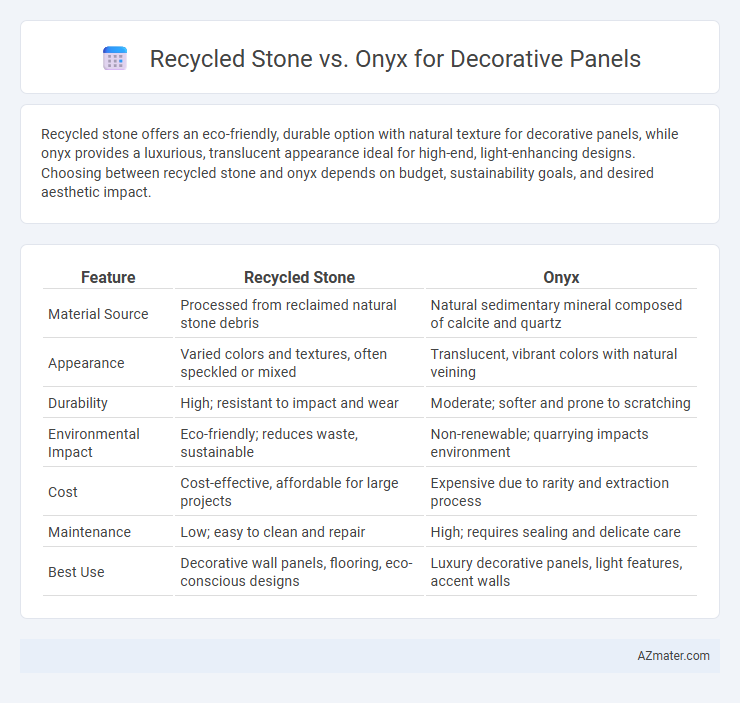Recycled stone offers an eco-friendly, durable option with natural texture for decorative panels, while onyx provides a luxurious, translucent appearance ideal for high-end, light-enhancing designs. Choosing between recycled stone and onyx depends on budget, sustainability goals, and desired aesthetic impact.
Table of Comparison
| Feature | Recycled Stone | Onyx |
|---|---|---|
| Material Source | Processed from reclaimed natural stone debris | Natural sedimentary mineral composed of calcite and quartz |
| Appearance | Varied colors and textures, often speckled or mixed | Translucent, vibrant colors with natural veining |
| Durability | High; resistant to impact and wear | Moderate; softer and prone to scratching |
| Environmental Impact | Eco-friendly; reduces waste, sustainable | Non-renewable; quarrying impacts environment |
| Cost | Cost-effective, affordable for large projects | Expensive due to rarity and extraction process |
| Maintenance | Low; easy to clean and repair | High; requires sealing and delicate care |
| Best Use | Decorative wall panels, flooring, eco-conscious designs | Luxury decorative panels, light features, accent walls |
Introduction to Decorative Panels
Decorative panels serve as versatile architectural elements that enhance interior aesthetics through various materials, including recycled stone and onyx. Recycled stone offers sustainability benefits and unique textural appeal, making it an eco-friendly choice for modern designs. Onyx provides a luxurious, translucent quality with rich veining that adds elegance and depth to decorative applications.
Overview of Recycled Stone Panels
Recycled stone panels are manufactured from natural stone fragments bonded with resin or cement, offering an eco-friendly alternative to traditional stone materials. These panels provide durability, versatility, and a wide range of textures and colors, making them ideal for decorative applications in interiors and exteriors. Compared to onyx, recycled stone panels typically offer greater sustainability and cost-effectiveness while maintaining a high-quality aesthetic appeal.
What is Onyx? Characteristics and Appeal
Onyx is a luxurious, translucent natural stone renowned for its striking banded patterns and vibrant colors ranging from creamy whites to deep reds and greens. Its unique translucency allows light to pass through, creating a captivating glow that enhances decorative panels with an elegant, sophisticated appeal. Onyx's delicate nature and susceptibility to scratching and etching make it best suited for low-traffic, purely aesthetic applications in interior design.
Aesthetic Differences: Recycled Stone vs Onyx
Recycled stone features a naturally varied texture with subtle earth tones that create an organic, rustic aesthetic ideal for eco-conscious interior designs. Onyx offers a strikingly translucent surface with rich, vibrant veining, producing a luxurious and dramatic visual effect often preferred for high-end decorative panels. The choice between recycled stone and onyx ultimately hinges on desired ambiance: recycled stone suits warm, textured environments while onyx elevates spaces with its luminous, elegant appearance.
Durability and Lifespan Comparison
Recycled stone panels offer exceptional durability due to their composite nature, resisting scratches, stains, and weathering while maintaining structural integrity for decades. Onyx, though prized for its translucent beauty, is softer and more prone to scratching, chipping, and fading, which can significantly reduce its lifespan in high-traffic or outdoor settings. Choosing recycled stone enhances long-term resilience and cost-efficiency, making it a superior option for decorative panels requiring sustained durability.
Environmental Impact and Sustainability
Recycled stone panels significantly reduce environmental impact by utilizing waste materials, lowering landfill contributions, and minimizing the need for quarrying compared to onyx, which is a natural stone requiring extensive mining processes that disrupt ecosystems. The sustainability of recycled stone is enhanced by its lower carbon footprint in production and transportation, as it often incorporates locally sourced scraps, unlike onyx that involves energy-intensive extraction and long-distance shipping. Choosing recycled stone for decorative panels supports circular economy principles, promoting resource efficiency and reducing the depletion of finite natural stone reserves.
Installation and Maintenance Factors
Recycled stone panels offer easier installation due to their lighter weight and consistent thickness, reducing labor time and costs compared to the denser, more fragile onyx which requires skilled handling to avoid cracking. Maintenance for recycled stone is generally low, requiring only regular cleaning with mild detergents, while onyx demands more delicate care, avoiding acidic cleaners and frequent polishing to maintain its natural translucency. The durability of recycled stone also ensures better resistance to scratches and stains, making it a practical choice for high-traffic decorative panel applications.
Cost Analysis: Recycled Stone vs Onyx Panels
Recycled stone panels offer a cost-effective alternative to onyx, typically priced 30-50% lower due to lower material and processing expenses. Onyx panels, known for their unique translucency and luxe aesthetic, command higher prices driven by rare extraction and intricate fabrication requirements. Budget-conscious projects prioritize recycled stone, while premium designs invest in onyx for its exclusive visual impact despite higher costs.
Versatility and Application Areas
Recycled stone offers exceptional versatility for decorative panels, seamlessly adapting to both indoor and outdoor environments such as kitchens, bathrooms, and facades due to its durability and eco-friendly composition. Onyx, prized for its translucent beauty and striking color variations, is primarily used in indoor applications like feature walls, backlit panels, and luxury countertops where aesthetic impact is paramount. While recycled stone excels in sustainability and broad applicability, onyx is favored for high-end, visually dramatic installations that require a refined, luminous appearance.
Choosing the Right Material for Decorative Panels
Recycled stone offers an eco-friendly, durable choice for decorative panels, blending sustainability with natural texture and unique patterns that enhance interior spaces. Onyx provides a luxurious, translucent appearance with vibrant color variations and can be backlit to create stunning visual effects, ideal for high-end aesthetic applications. Selecting between recycled stone and onyx depends on balancing environmental impact, budget considerations, and the desired visual impact for the decorative panel installation.

Infographic: Recycled stone vs Onyx for Decorative Panel
 azmater.com
azmater.com